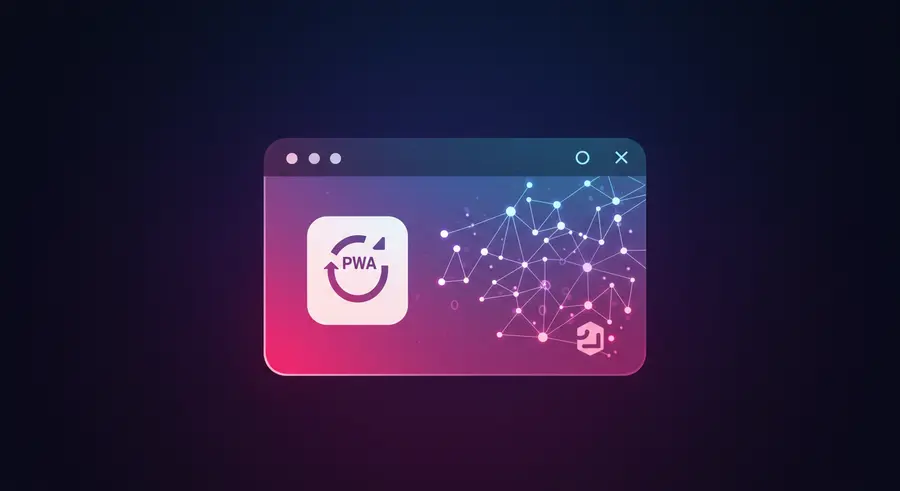Appearance

Welcome, tech innovators and web enthusiasts! 👋 Today, we're diving deep into a truly transformative synergy that's reshaping the digital landscape: the integration of Artificial Intelligence (AI) with Progressive Web Apps (PWAs). This isn't just about making websites smarter; it's about building a future where web experiences are incredibly intelligent, responsive, and deeply personalized.
What are Progressive Web Apps (PWAs)? 🤔
Before we unleash the power of AI, let's quickly recap what PWAs bring to the table. For a more detailed dive into the foundational elements of PWAs, check out our guide on Core PWA Features: Service Workers and Manifest. In essence, PWAs are web applications that leverage modern web capabilities to deliver an app-like experience to users. Think of them as the best of both worlds:
- Reliable: They load instantly, regardless of network conditions, thanks to service workers caching resources.
- Fast: Smooth animations and fluid scrolling make for a seamless user experience.
- Engaging: They offer features traditionally limited to native apps, like push notifications, offline access, and homescreen icons.
The Dawn of AI-Powered PWAs: A Game Changer 🚀
Now, imagine coupling these incredible PWA capabilities with the intelligence of AI. The result? A new generation of web applications that can learn, adapt, and predict user needs, offering truly hyper-personalized experiences. Here's how AI is supercharging PWAs:
1. Hyper-Personalization Beyond Limits 🎯
AI algorithms can analyze user behavior, preferences, and historical data to deliver content, recommendations, and interfaces tailored to each individual. For instance:
- E-commerce PWAs: AI can power recommendation engines that suggest products based on browsing history, past purchases, and even real-time interactions, leading to higher conversion rates.
- Content Platforms: News and blog PWAs can use AI to curate personalized feeds, ensuring users see the most relevant articles and topics.
- Travel Apps: Imagine a PWA that learns your travel preferences and proactively suggests destinations, deals, and even local activities based on your past trips and real-time data.
This level of personalization creates a deeply engaging experience that keeps users coming back.
2. Enhanced User Experience with Intelligent Interactions 💬
AI can dramatically improve how users interact with PWAs:
- Smart Chatbots & Virtual Assistants: Integrate AI-powered chatbots directly into your PWA to provide instant customer support, guide users, and even complete transactions. These aren't just rule-based bots; they understand natural language and learn from every interaction.
- Voice Search Optimization: As voice interfaces become more prevalent, AI enables PWAs to understand complex voice queries, offering a hands-free and intuitive way to navigate and interact with the application.
- Predictive Text and Auto-completion: AI can predict user input in forms and search bars, reducing typing effort and speeding up data entry.
3. Optimized Performance and Efficiency ⚡
AI isn't just about user-facing features; it's also a powerhouse for behind-the-scenes optimization:
- Intelligent Caching: AI can predict which content a user is likely to access next and preemptively cache it using service workers, leading to even faster load times and smoother offline experiences.
- Resource Management: AI can dynamically manage resource loading, prioritizing critical assets and deferring non-essential ones, ensuring optimal performance across various network conditions and devices.
- A/B Testing & Optimization: AI can automate and optimize A/B testing, quickly identifying the most effective UI/UX elements and content strategies based on user engagement metrics.
4. Advanced Hardware Access & Capabilities 📸📍
PWAs are already breaking free from traditional browser limitations, and AI is amplifying this by leveraging device hardware more intelligently:
- Image Recognition & Processing: An AI-powered PWA could use device cameras for real-time image recognition (e.g., identifying plants, scanning barcodes, or translating text).
- Location-Based Services: With AI, location data can be used more intelligently to offer highly relevant, context-aware services, like personalized local recommendations or smart navigation based on user habits.
- Biometric Authentication: Enhance security and convenience by integrating AI-driven biometric authentication (fingerprint, facial recognition) directly into your PWA for seamless logins and secure transactions.
The Future is Now: Building Intelligent PWAs 🛠️
The convergence of AI and PWAs is not just a theoretical concept; it's actively being implemented by leading companies to create cutting-edge web experiences. To get started with your own intelligent PWA, consider these key aspects:
- Choose the Right AI Services: Leverage cloud-based AI services (e.g., Google Cloud AI, AWS AI/ML, Azure AI) for natural language processing, computer vision, recommendation engines, and more.
- Embrace Modern Web Technologies: Continue to build on the strong foundation of modern JavaScript frameworks (React, Vue, Angular) and PWA essentials like Service Workers and Web App Manifests.
- Focus on Data Privacy: As AI relies on data, ensure you implement robust data privacy and security measures, adhering to regulations like GDPR and CCPA. Transparency with users about data usage is paramount.
The symbiotic relationship between AI and PWAs is paving the way for a more intelligent, personalized, and efficient web. By embracing these advancements, developers can craft truly revolutionary digital experiences that blur the lines between traditional websites and native applications, setting new standards for user engagement and satisfaction.
The revolution has begun – are you ready to be a part of it? 💡